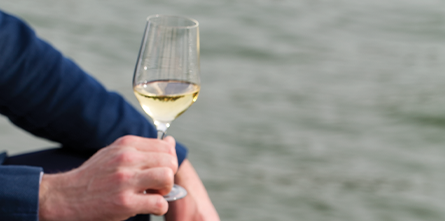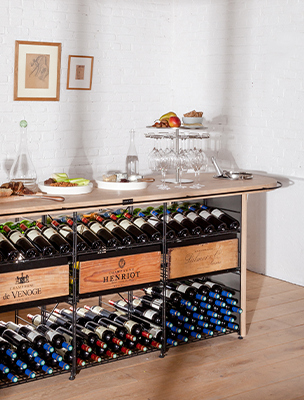
Is the 2024 harvest ready to deliver an exceptional new vintage? One thing is for sure: despite the sharp drop in production this year (18% lower according to the French Ministry of Agriculture), we’re expecting wines that stand out from the crowd. The extreme climatic conditions (heatwaves, dry spells, heavy rain and hail) which sorely tested the winegrowers may in fact have imbued the wines with remarkable character. With the harvest in full swing, the quantity and quality of this future vintage now rest in the balance. As a manufacturer of wine tools based in Champagne since 1926 and owned by the same family for three generations, L’Atelier du Vin is keeping a close eye on events. So dive in with us as we review the results of the 2024 harvest!
The weather challenges of 2024
Due to global warming, harvests have been occurring earlier and earlier. In Champagne, for example, harvesting in the 1970s usually took place at the end of September or beginning of October. Imagine the extent to which winegrowing has now been disrupted! This year’s rainy summer in the northern part of France kept the grapevines from maturing in a timely manner and encouraged the outbreak of fungal diseases such as mildew. The winegrowers see this harvest as a much-deserved victory over the temperamental weather conditions they faced.

This includes the intense heatwave that blanketed the French wine regions with temperatures approaching 40°C (104°F)! A dry spell then settled in, putting the vines to the test. The result? A drastic drop in yield in Languedoc-Roussillon, Bordeaux, Alsace and the Pyrénées-Orientales. Some vineyards recorded losses of up to 80%. Although France produced approximately 45 million hectoliters (1.2 billion gallons) last year, the Ministry estimates that the 2024 harvest totaled only 39.3 million hectoliters (1 billion gallons).
Despite these challenges, our winegrowers showed incredible tenacity, resourcefulness, and passion! They implemented targeted irrigation techniques and fungal treatments. The vines were able to adapt, which stimulated the ripening of the grapes; this in turn increased the aromatic concentration and maintained a balanced acidity, key elements that determine the quality of a wine. We thus expect wines characterized by their bright fruitiness and freshness. This expectation has already been confirmed in Burgundy as well as Bordeaux, where the first white wines from the Pessac region possess a highly aromatic and invigorating character.

2024 promises to be an assuredly exceptional vintage, the fruit of the diligent work carried out by our winegrowers throughout the entire season. Such diligence is even more crucial in organic viticulture, where every detail counts. And despite everything, this harvest promises to yield bunches of grapes perfect for making memorable wines.
2024 Harvest Tour of France

Champagne: unwavering quality
The 2024 harvest in Champagne began on September 7 except for the chardonnays (30% of the Champagne region’s grape production); these ripened more slowly and will be harvested later on at the end of the month. Despite the challenges posed by the rain, hail, mildew and a drop in production, the favorable conditions arising at the end of the season should guarantee high-quality grape bunches. The winegrowers are expecting a marketable yield of 10,000 kg per hectare (8,900 lbs. per acre), which is 1,400 kg less than in 2023, for a total production of 280 million bottles of wine. Sparkling wine fans will be absolutely thrilled! The grape bunches successfully maintained a good balance between their sugar content and acidity thanks to the chilly nights.
Bordeaux and the Southwest: promising grape bunches
The Bordeaux wine producers have been busy harvesting since the end of August, and the forecasts are looking to be quite favorable. Thanks to a mild winter and plentiful rain, the intense heat, dry spells and threat of fungus were not enough to affect the Bordeaux grapevines. The Merlot and Cabernet Sauvignon varieties ripened particularly well, providing the promise of richly aromatic wines perfect for wine tasting evenings at home. And in the Southwest, the winegrowers are still smiling despite some last-minute rain.
Burgundy: A one-of-a-kind vintage
The 2024 harvest is turning out to be a real challenge for the winegrowers in the Burgundy region. After monumental efforts to cope with the intense heat, hail, mildew and black rot, they were able to achieve grape bunches rich in subtle and elegant aromas. Their ripening and yield were not consistent, but it will remain a quality harvest. With its pleasing acidity, the Chardonnay grape is perfect for creating excellent sparkling wines, while the Pinot Noir promises exceptional red wines.

Alsace: a sharp drop, but quality was maintained
As with the other winegrowing regions, production in Alsace dropped, in this case to 900,000 hectoliters (23.78 million gallons), down 60,000 hectoliters (1.6 million gallons) compared to 2023. The grape bunches dedicated to producing sparkling wines were harvested on August 29, whereas those for the “Alsace” AOC still wines were harvested starting on September 9. The harvests were later compared to the previous year, but no need to worry! The Gewurztraminer and Riesling varieties still promise to provide dry white wines and mellow wines bursting with aroma.
Loire Valley: a festive harvest despite all
Grapes with varying degrees of ripeness combined with good end-of-summer conditions and effective phytosanitary control promise elegant white wines with delicate aromas as well as light and fruity reds. The harvested Chenin Blanc, Sauvignon Blanc and Cabernet Franc varieties are sufficiently sweet and fresh. As a matter of fact, on September 7, the 13th edition of the Cheverny Harvest Festival captivated visitors with tastings of Cheverny AOC red, white and rosé wines as well as Cour Cheverny AOC white wines.
Côtes du Rhône and Beaujolais: an uneventful harvest
Côtes du Rhône and Beaujolais, two regions known for their fruity and spicy red wines, suffered the least from the weather’s vagaries. We can expect a wonderful vintage thanks to fully ripened grapes with very thick skins from which plenty of color can be extracted. The 2024 harvest ban was officially lifted so that the harvest could start on September 4 for Beaujolais and August 4 for the Côtes du Rhône.

Provence and Corsica: resistance equals reward
Winegrowers from the Var, Alpes-Maritimes and Bouches-du-Rhône began harvesting their grapes on August 21. This region, renowned for its rosés, successfully resisted the summer’s heatwaves thanks to spring rains. However, yields were mixed due to the ravages caused by hail and frost on some plots. In Corsica, the harvest was one of the earliest to occur. This was particularly true for the Patrimonio PDO winegrowing region, which began harvesting on August 10. Nevertheless, this vintage still shows promise.
Languedoc-Roussillon: Early yet fruitful harvests
In order to prevent the phenomenon of concentration from occurring, the harvesting of vineyards in Aude commenced on July 30, the earliest it has ever begun. Despite this, the grapes ripened well, thus ensuring a quality vintage. They retained their fresh notes and high concentrations of thiols, thus providing the white wines (Sauvignon Blanc and Colombard) with a highly prized freshness and intensity.

Jura: enormous losses, yet the promise of quality remains
In terms of yield, Jura was without a doubt the most affected wine region, recording a loss of between 60 and 70% of its harvest. The media has labeled it a “historic loss” due obviously to the very harsh weather conditions. In the hilly area of Domblans, the Savagnin variety produced less than 15 small-sized grape bunches per vine stock. A long period of spring frost was to blame. Fortunately, we can still expect the harvest to produce quality wines!
The 2024 harvest: initial prospects
This year, wine making takes center stage! Certain producers are planning to use more stainless-steel tanks to preserve aromatic freshness, while others are choosing to use barrels for aging in order to confer added complexity to their red wines.
Here are the initial trends observed with the 2024 vintage:
- White wines: We expect to obtain fresh aromatic wines thanks to the balance between acidity and sugar content.
- Red wines: The reds should exhibit good tannic structure with strong aging potential.
- Rosés: Provence should produce elegant rosés with pleasing freshness.
- Sparkling wines: In Champagne, we expect to see an excellent balance between rich aromas and acidic freshness.
Although it’s too early to draw definitive conclusions, the winegrowers’ optimism is almost palpable. The 2024 vintage may just turn out to be a memorable year despite all the complications thanks to the resilience of the grapevines and the producers’ expertise.

Conclusion
The 2024 harvest is likely to produce a vintage full of promises despite the climatic challenges weathered throughout the year. The French winegrowers successfully demonstrated their adaptability when faced with extreme conditions. While we itch to see the winemakers’ final results, it is clear that this vintage could have big surprises in store for us. For those who wish to find out more about these promising future vintages, L’Atelier du Vin invites you to discover its new collection of wine-tasting tools!

Copyrights.
Editorial, visual and graphic elements strictly linked to copyrights. For any request of partial or total use, contact us.
© Marie Lukasiewicz




